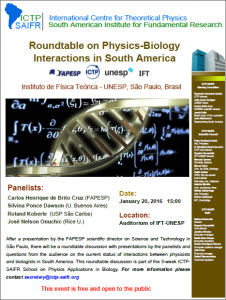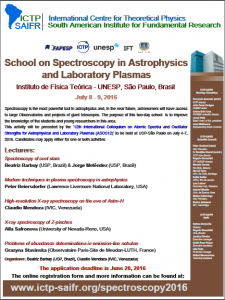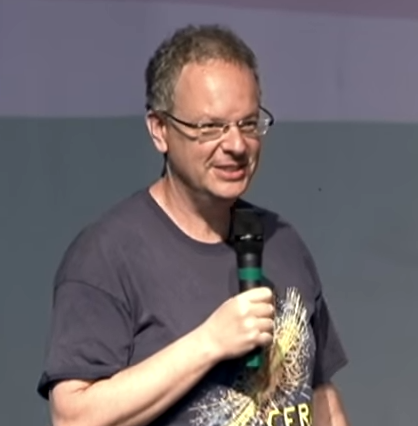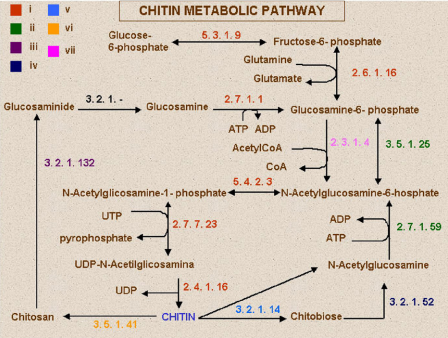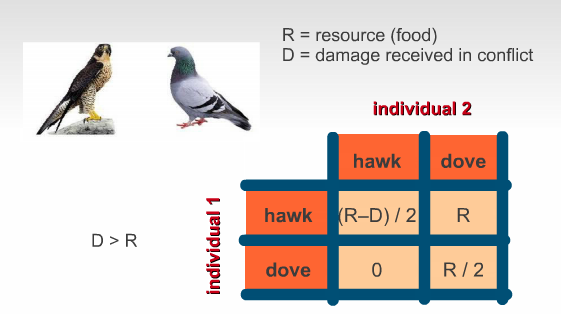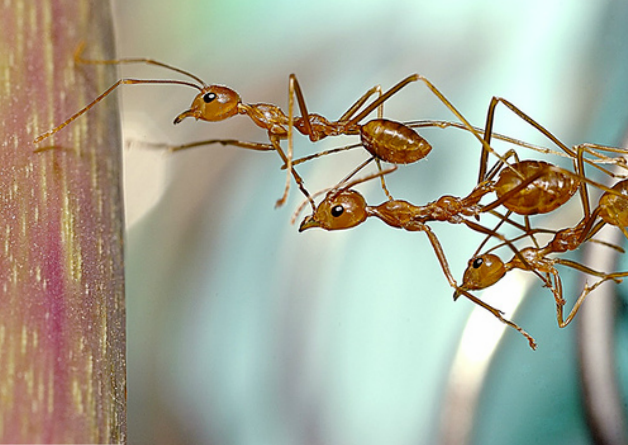Search Results
Roundtable on Physics-Biology Interactions in South America

Time: Wednesday, January 20 , 15:00 – 17:00
Place: Auditorium of IFT-UNESP
Panelists:
- Carlos Henrique de Brito Cruz (FAPESP)
-
Silvina Ponce Dawson (U. Buenos Aires)
-
Roland Koberle (USP São Carlos)
-
José Nelson Onuchic (Rice U.)
After a presentation by the FAPESP scientific director on Science and Technology in São Paulo, there will be a roundtable discussion with presentations by the panelists and questions from the audience on the current status of interactions between physicists and biologists in South America. This roundtable discussion is part of the 3-week ICTP-SAIFR School on Physics Applications in Biology. For more information please contact secretary@ictp-saifr.org
This event is open to the general public.
Announcement
Photos:
Continue Reading | Comments Off on Roundtable on Physics-Biology Interactions in South America
School on Spectroscopy in Astrophysics and Laboratory Plasmas
- Laboratory Plasmas
Start time: July 8, 2016
Ends on: July 9, 2016
Location: São Paulo, Brazil
Venue: IFT-UNESP
Organizers:
- Beatriz Barbuy (Universidade de São Paulo, Brazil )
- Claudio Mendoza (Western Michigan University, USA)
Lecturers:
- Beatriz Barbuy (USP, Brazil) & Jorge Meléndez (USP, Brazil): Spectroscopy of cool stars
- Peter Beiersdorfer (Lawrence Livermore National Laboratory, USA): Modern techniques in plasma spectroscopy in astrophysics
- Claudio Mendoza (Western Michigan University, USA): High-resolution X-ray spectroscopy on the eve of Astro-H
- Alla Safronova (University of Nevada-Reno, USA): X-ray spectroscopy of Z-pinches
- Grazyna Stasinska (Observatoire Paris-Site de Meudon-LUTH, France): Problems of abundance determinations in emission-line nebulae
Description:
This activity will be preceded by the ‘12th International Colloquium on Atomic Spectra and Oscillator Strengths for Astrophysical and Laboratory Plasmas (ASOS12)’ to be held at USP-São Paulo on July 4-7, 2016.
Announcement
Timeline
May 1, 2016: Abstract submission deadline (Conference ASOS-12)
May 15, 2016: Notification on accepted contributed talks (Conference ASOS-12)
June 1, 2016: End of early registration fee period
June 20, 2016: End of regular registration period
School Program: updated on June 15
The Program for the 12th International Colloquium on Atomic Spectra and Oscillator Strengths for Astrophysical and Laboratory Plasmas (ASOS12), July 4-7, 2016, is available here. Click on (PDF) to download the files.
|
Friday, July 8 |
Saturday, July 9 |
|
|
09:30 – 11:00 |
X-ray spectroscopy of Z-pinches (Alla Safronova) (PDF)
|
Spectroscopy of cool stars (Beatriz Barbuy & Jorge Meléndez) |
|
11:00 – 11:30 |
Coffee Break |
Coffee Break |
|
11:30 – 13:00 |
Modern techniques in plasma spectroscopy in astrophysics (Peter Beiersdorfer) (PDF)
|
Hands-on session (Beatriz Barbuy & Jorge Meléndez) Computer Lab |
|
13:00 – 14:30 |
Lunch |
Lunch |
|
14:30 – 16:00 |
Problems of abundance determinations in emission-line nebulae (Grazyna Stasinska) (PDF)
|
|
|
16:00 – 16:30 |
Coffee Break |
|
|
16:30 – 18:00 |
High-resolution X-ray spectroscopy on the eve of Astro-H (Claudio Mendoza)
|
|
|
18:00 – 19:00 |
Discussion
|
Satisfaction Survey:
Photos
Lectures Summary:
=====================================================================================================================================
Beatriz Barbuy (USP, Brazil) & Jorge Meléndez (USP, Brazil): Spectroscopy of cool stars
=====================================================================================================================================
We will describe atomic and molecular spectral lines observed in spectra of cool stars, and how to measure them. The analysis of stellar spectra and derivation of stellar parameters effective temperature, gravity, metallicity and microturbulence velocity will be explained. Spectrum synthesis will be described. Where to access data bases on line oscillator strengths, and other atomic physics parameters, and line lists of molecular lines will be given. Elements of nucleosynthesis will be described.
=====================================================================================================================================
Peter Beiersdorfer (Lawrence Livermore National Laboratory, USA): Modern techniques in plasma spectroscopy in astrophysics
=====================================================================================================================================
Spectroscopy in the extreme ultraviolet (EUV) and x-ray regime provides a window on the hottest plasmas and the most energetic prcoesses in the universe. It is used, for example, to derive metal abundances, temperatures, flow velocities, and densities. In this lecture I will describe targeted experiments using plasma sources on Earth to reproduce various aspects of the conditions thougtht to exist in the universe in order to test and improve our understanding of x-ray and EUV spectra from astrophysical objects.
=====================================================================================================================================
Claudio Mendoza (Western Michigan University, USA): High-resolution X-ray spectroscopy on the eve of Astro-H
=====================================================================================================================================
With the launch of the Chandra and XMM-Newton space observatories in 1999, X-ray astronomy came of age,where a series of exciting discoveries have led to unprecedented breakthroughs in, for instance,cosmology, the physics of compact objects, production of heavy elements in supernova remnants, the feedback of active-galactic-nuclei in galaxies and the magneto-hydrodynamics of flares and coronal loops. The new Astro-H mission (February 2016) will provide a combination of a wide band (5-80 keV) and the improved resolution of ~5 eV in the 0.3-10 keV bandpass. It is expected to open new research endeavors related to the large-scale structures of the universe, strong gravitational fieldsand the formation and evolution of galaxies and galaxy clusters. In the present talk we give an overview of the atomic properties of the observed lines, the plasma diagnostics that are used, research highlights, the Astro-Hspectral capabilities and its new science objectives.
=====================================================================================================================================
Alla Safronova (University of Nevada-Reno, USA): X-ray spectroscopy of Z-pinches
====================================================================================================================================
The lecture will begins with a description of atomic processes including X-ray line polarization and then moves to non-LTE calculations and importance of EBIT data for benchmarking of atomic data. The examples of X-ray K-, L-, and M-shell spectra produced on 1 MA Z-pinch generator and their interpretation will be considered as well as some of the X-ray spectra relevant to astrophysics.
=====================================================================================================================================
Grazyna Stasinska (Observatoire Paris-Site de Meudon-LUTH, France): Problems of abundance determinations in emission-line nebulae
====================================================================================================================================
I will present the different methods to determine the chemical composition of emission-line nebulae (mainly HII regions and planetary nebulae), emphasizing the advantages and drawbacks of each of them. I will then discuss some of the still unsolved problems that plague the abundances derived from nebular emission lines (abundance discrepancies, temperature fluctuations, abundance inhomogeneities, kappa distribution of free electrons).
====================================================================================================================================
Additional Information:
List of Confirmed Participants: Updated on July 1
Registration: ALL participants and speakers should register. The registration will be on July 4 at USP, from 8:00 to 9:00. You can find arrival instructions to USP here.
Accommodation: Participants, whose accommodation has been provided by the institute will stay at The Universe Flat. Each participant, whose accommodation has been provided by the institute, has received the accommodation details individually by email.
IMPORTANT: From July 4 to 7, the activity will be held at USP, and from July 8 to 9, at IFT-UNESP. You can find the arrival instructions to IFT-UNESP here.
BOARDING PASS: All participants , whose travel has been provided or will be reimbursed by the institute, should bring the boarding pass upon registration, and collect an envelope to send the return boarding pass to the institute.
Emergency number: 9 8233 8671 (from São Paulo city); +55 11 9 8233 8671 (from abroad), 11 9 8233 8671 (from outside São Paulo).
Ground transportation instructions:
Ground transportation from Guarulhos Airport to The Universe Flat
Ground transportation from Congonhas Airport to the Universe Flat
Ground transportation from The Universe Flat to the institute
Continue Reading |
Comments Off on Laboratory Plasmas
Dark Matter day in São Paulo

November 23, 2015
ICTP-SAIFR, São Paulo, Brazil
Auditorium of IFT-UNESP
Description:
The goal of this meeting is to get together everybody that has been working in the field of DM at some point – or is simply interested in the field now – and lives somewhere in the vicinities of the state of São Paulo. By getting to know each other and our own active research fields, we aim at developing new projects within Brazil and South-America, first steps to build a DM community in the area.
Program:
| Start | End | Talks |
| 10:00 | 10:15 | WELCOME |
| 10:15 | 10:45 | DM direct detection and the DAMIC experiment (Diego Torres Machado) |
| 10:45 | 11:05 | Indirect DM searches with charged Cosmic Rays (Manuela Vecchi) |
| 11:05 | 11:25 | Search for DM annihilation in radio emission from the Large Magellanic Cloud (Beatriz Blanco Siffert) |
| 11:25 | 11:50 | COFFEE BREAK |
| 11:50 | 12:10 | Primordial Black Holes as DM (Encieh Erfani) |
| 12:10 | 12:30 | Indirect signatures from dark-baryonic matter (Chee Sheng Fong) |
| 12:30 | 12:50 | Z_2 SIMP Dark Matter (Nicolas Bernal) |
| 12:50 | 14:50 | LUNCH |
| 14:50 | 15:10 | Statistical mechanics of self-gravitating systems: mixing as a criterion for indistinguishability (Leandro Berardo e Silva) |
| 15:10 | 15:30 | The Dark Matter distribution of the Milky Way (Fabio Iocco) |
| 15:30 | 17:00 | DISCUSSION |
| 17:00 | 17:30 | COFFEE BREAK |
| 17:30 | 19:30 | WORKING GROUPS |
| 20:30 | SOCIAL DINNER (not financially supported) |
Participants:
- Ana Amelia Bergamini Machado (IFGW – UNICAMP)
- Beatriz Blanco Siffert (UFRJ)
- Clara Watanabe (UFRJ)
- Chee Sheng Fong (IF-USP)
- Diego Torres Machado (UFRJ)
- Encieh Erfani (Institute for Research in Fundamental Sciences, Tehran)
- Fabio Iocco (ICTP-SAIFR & IFT-UNESP)
- Fabio Santos (PUC-Rio de Janeiro)
- German Gomez Vargas (Universidad Católica de Chile)
- João Torres de Mello Neto (UFRJ)
- Jonas Enander (OKC Stockholm)
- Leandro Berardo e Silva (USP)
- Luciano Casarini (UFES)
- Manuela Vecchi (IFSC-USP)
- Maria Benito (IFT-UNESP)
- Maria Fernanda Cerini (UNICAMP)
- Maria Catalan Cabrera (IF-USP)
- Nicolas Bernal (ICTP-SAIFR)
- Rogerio Rosenfeld (ICTP-SAIFR & IFT-UNESP)
- Victor Braga Mello (UFRJ)
Organizers:
- Manuela Vecchi (IFSC-USP)
- Fabio Iocco (IFT-UNESP & ICTP-SAIFR)
Continue Reading | Comments Off on Dark Matter day in São Paulo
Physics and philosophy
Rogério Rosenfeld took part in debates with Antonio Cicero on the 5th Art and Science edition, and discussed what we currently know and don’t know about the universe
Over the last few weeks, Rogério Rosenfeld, current director of IFT/Unesp and vice-director of ICTP-SAIFR, took part in a series of debates to talk about science and his area – from the microscopic world of Particle Physics to the macroscopic one of galaxies and the universe. The events were part of the 5th Art and Science edition, which brings together professionals from different areas for a series of lectures and discussions in cities throughout Brazil.
Click here to watch one of Rogério Rosenfeld’s talks on the 5th Art and Science edition.
“I enjoyed being part of this initiative because I had the opportunity to talk about science and about my area for the general public, and I think science communication is essential”, says Rogério.
Of the four debates Rogério participated in, three were with the philosopher Antonio Cicero. The theme of these events was the universe: how is the dialogue today between physics and philosophy when it comes to its origin and its mysteries, as dark matter and dark energy?
What we know that we know
In his lectures, Rogério first talked about “what we know that we know” about the universe. At the microscopic extreme, we learned over the centuries that matter is consisted of atoms, that they are divisible into electrons and the nucleus, and that the nucleus is made of neutrons and protons. With scientific and technological advances, we discovered that even these particles could be broken down into quarks. And so the Standard Model was created – a kind of periodic table of the elementary particles of nature. The last major discovery in the area was the detection of the Higgs boson at the LHC in 2012, which completed the model.
In the macroscopic end, we know the age of the universe – 13.7 billion years – we know that it is not static – it’s expanding – and in 1998 we found out that, contrary to what everyone thought, the expansion is accelerating. We also know that the universe is composed of only about 5% of matter as we know it – 24% is dark matter and 71% is dark energy.
What we know that we don’t know
Then Rogerio talked about “what we know that we don’t know”.
“There’s a lot we don’t know about the universe, but at least we know that we don’t know, which is very important,” said Rogério.
An example is the existence of particles beyond the Standard Model – there is the possibility that there are particles in the universe which we couldn’t observe until today. We also know that we don’t know what is dark matter made of and what is dark energy, responsible for the mysterious accelerating expansion of the universe.
“I just didn’t talk about what we don’t know that we don’t know because… I don’t know it”, said the researcher.
Debate
In his talk, Antonio Cicero spoke mainly about the Ápeiron. The word of Greek origin, that means “unlimited, infinite,” refers to the central idea of a cosmological theory created by Anaximander in the sixth century BC. According to it, the ultimate reality, called arché, is eternal and infinite and is not subjected to age or disintegration.
Rogerio provoked Antonio Cicero saying that, in physics, the infinite doesn’t exist.
“How many grains of sand are there on a beach? How many atoms on the planet? A lot, but not infinite. When, in a theory, we find an “infinite”, we know that there is a problem with it”.
The debate was followed by questions from the audience and, at the end, Rogério and Cícero agreed that, despite the fact that philosophy and physics had the same origin, today the areas are quite different.
Click here for more information on the Art and Science events.
Continue Reading | Comments Off on Physics and philosophy
Física e filosofia
Rogério Rosenfeld participa de debates com Antônio Cícero no 5º Ciclo Arte e Ciência, e discute sobre o que atualmente sabemos e não sabemos a respeito do universo
Ao longo das últimas semanas, Rogério Rosenfeld, atual diretor do IFT/Unesp e vice-diretor do ICTP-SAIFR, participou de uma série de debates para falar sobre ciência e sobre sua área – desde o universo microscópico da Física de Partículas até o macroscópico das galáxias e do universo. Os eventos fizeram parte do 5º Ciclo Arte e Ciência, que reúne profissionais de diferentes áreas para uma série de palestras e debates em cidades espalhadas pelo Brasil.
Clique aqui para ver uma das palestras de Rogério Rosenfeld no 5º Ciclo Arte e Ciência.
“Gostei de participar da iniciativa, pois tive a oportunidade de falar sobre ciência e sobre a minha área para o público geral e acho que fazer divulgação científica é essencial”, diz Rogério.
Dos quatro debates que Rogério participou, três foram com o filósofo Antônio Cícero. O tema dos eventos foi o universo: como está hoje o diálogo entre física e filosofia quando se trata da sua origem e de seus mistérios, como matéria e energia escura?
O que sabemos que sabemos
Em suas palestras, Rogério falou primeiro sobre “o que sabemos que sabemos” em relação ao universo. No extremo microscópico, aprendemos ao longo dos séculos que a matéria é constituída por átomos, que eles são divisíveis em elétrons e núcleo, e que o núcleo é composto por nêutrons e prótons. Com o avanço da ciência, descobrimos que até essas partículas podem ser quebradas em quarks. Assim, foi criado o Modelo Padrão – uma espécie de tabela periódica das partículas elementares da natureza. A última grande descoberta da área foi a detecção do Bóson de Higgs pelo LHC em 2012, que completou o Modelo.
Já no extremo macroscópico, sabemos a idade do universo – 13,7 bilhões de anos -, sabemos que ele não é estático – está expandindo – e, em 1998, descobrimos que, ao contrário do que todos pensavam, a expansão é acelerada. Sabemos também que o universo é composto por apenas cerca de 5% de matéria como a conhecemos – 24% é matéria escura e 71% é energia escura.
O que sabemos que não sabemos
Em seguida, Rogério falou sobre “o que sabemos que não sabemos”.
“Há muito que não sabemos sobre o universo, mas pelo menos sabemos que não sabemos, e isso já é muito importante”, disse Rogério.
Um exemplo disso é a existência de partículas além do Modelo Padrão – há a possibilidade de que existam partículas no universo que nós não conseguimos observar até hoje. Também sabemos que não sabemos do que é feita a matéria escura e o que é a energia escura, responsável pela misteriosa aceleração da expansão do universo.
“Só não falei sobre o que não sabemos que não sabemos porque…eu não sei”, brincou o pesquisador.
Debate
Em sua palestra, Antônio Cícero falou, principalmente, sobre o Ápeiron. A palavra de origem grega, que significa “ilimitado, infinito”, se refere à ideia central de uma teoria cosmológica criada por Anaximandro, no século VI a.C. De acordo com ela, a realidade última, chamada de arché, é eterna e infinita e não está sujeita a idade ou desintegração.
Rogério provocou Antônio Cícero afirmando que, na Física, o infinito não existe.
“Quantos grãos de areia existem em uma praia? Quantos átomos no planeta? São muitos, mas não infinitos. Quando, em uma teoria, encontramos um “infinito”, sabemos que há um problema com ela”.
O debate seguiu com perguntas do público e, ao final, Rogério e Cícero concordaram que, apesar da origem da Filosofia e da Física ser a mesma, hoje as áreas são bastante diferentes.
Para saber mais sobre o Ciclo Arte e Ciência e seus eventos, clique aqui.
Continue Reading | Comments Off on Física e filosofia
Complex networks and neuroscience
Throughout the School on Complex Networks and Neuroscience, held at ICTP-SAIFR from September 28th to October 16th, Claudio Mirasso, from the Universitat de les Illes Balears, in Spain, talked about the relation between complex networks and brain research. The physicist, who was also one of the event’s organizers, pointed out how, on one hand, ideas from physics can help us understand neuroscience and, on the other, the way the brain functions may contribute to research in physics.
Brain Functioning
One of Mirasso’s interests is understanding the synchronization between different brain regions.
“In electroencephalography (EEG) studies we see that different brain regions, often not structurally connected, are synchronized”, he says. “Through studies with complex networks, we try to understand this synchronization and the exchange of information between different brain areas”.
One of the reasons for the synchronizations, according to the researcher, is that regions have similar or complementary roles. When we see an object, for instance, information about its shape, color and position in space are sent to the brain, and different areas are activated to process this set of data.
“Among our most recent results, we found that the thalamus is one of the main areas responsible for coordinating this synchrony”, said Mirasso.
Information Processing
If complex networks help us understand how the brain works, the opposite can also happen – especially when it comes to processing information.
“We are living in the era of information”, says Mirasso. “The amount of data we have increases every day, so we need new ways to process all this information”.
One way to make this processing more efficient is to previously sort only the data of interest. This is the technique used by the brain: every second we are bombarded with thousands of visual, sensory and auditory stimuli. However, just relevant information is processed.
“Studying how the brain filters and processes information and trying to copy it can help us create more efficient ways to process data on computers,” says Mirasso.
The brain can also contribute to improve facial and voice recognition engines. Although computers are more efficient than humans when calculating, for example, we are much better when it comes to differentiating faces and voices. Research about what makes our brains specialists in these tasks is a way to improve computer systems that try to distinguish different faces and sounds.
Continue Reading | Comments Off on Complex networks and neuroscience
Redes complexas e neurociência
Ao longo da Escola em Redes Complexas e Neurociências, realizada no ICTP-SAIFR entre os dias 28 de setembro e 16 de outubro, Claudio Mirasso, da Universitat de les Illes Balears, da Espanha, falou sobre a relação entre redes complexas e estudos do cérebro. O pesquisador, um dos organizadores do evento, ressaltou como, por um lado, ideias da Física podem ajudar em trabalhos de neurociência e, por outro, como a maneira do cérebro funcionar pode contribuir para pesquisas de ciências exatas.
Funcionamento Cerebral
Um dos interesses de Mirasso é entender a sincronia entre diferentes regiões do cérebro.
“Com estudos de eletroencefalografia (EEG) vemos que regiões do cérebro, muitas vezes não conectadas estruturalmente, estão sincronizadas”, diz ele. “Através de estudos com redes complexas, buscamos compreender como ocorre essa sincronia e a troca de informações entre as diferentes áreas cerebrais”.
Um dos motivos pelos quais isso ocorre, segundo o pesquisador, é que as regiões têm funções semelhantes ou complementares. Quando vemos um objeto, por exemplo, informações sobre sua forma, cor e posição no espaço chegam ao cérebro, e diferentes áreas são ativadas para processar esse conjunto de informações.
“Entre nossos resultados mais recentes, observamos que o tálamo é um dos principais responsáveis pela coordenação dessa sincronia”, afirma Mirasso.
Processamento de informação
Se redes complexas ajudam a entender como o cérebro funciona, o contrário também pode acontecer – principalmente quando se trata de processamento de informações.
“Estamos vivendo a era da informação”, diz Mirasso. “A quantidade de dados aumenta a cada dia e, por isso, precisamos de novas formas para processar toda essa informação”.
Uma das maneiras de tornar o processamento mais eficiente é separar, previamente, apenas os dados de interesse. Essa técnica é a mesma empregada pelo cérebro: todos os segundos somos bombardeados com milhares de estímulos visuais, sensoriais, auditivos e de outras naturezas. Entretanto, apenas o que é relevante é processado.
“Estudar como o cérebro filtra e processa informação e tentar copiá-lo pode nos ajudar a criar maneiras mais eficientes de processar dados em computadores”, afirma Mirasso.
O cérebro também pode contribuir no aprimoramento de mecanismos de reconhecimento facial e de voz. Apesar de computadores serem mais eficientes do que humanos ao realizar cálculos, por exemplo, nós somos muito superiores para diferenciar rostos e vozes. Pesquisar o que torna nossos cérebros especialistas nessas funções é um caminho para aprimorar sistemas computacionais que tentam discernir diferentes faces e sons.
Continue Reading | Comments Off on Redes complexas e neurociência
Colloquium discusses complex networks and evolution
In last Wednesday’s colloquium, researcher Roberto Andrade, from the Universidade Federal da Bahia, talked about his latest works involving complex networks for the study of evolution. Andrade and his group propose a new method for organizing species and their evolution, traditionally done through phylogenetic trees based on morphology and molecular characteristics.
“Our proposal is to classify organisms based on similarities of components involved in the synthesis of basic molecules”, says Andrade. “In our work, we studied fungi based on chitin. Then, in a more ambitious project, we studied the evolutionary origins of the mitochondria”.
The researcher explains that many organisms have their own set of enzymes to obtain a molecule that is found in many different species. Therefore, by studying differences between cell machinery, it’s possible to classify organisms by their genetic proximity.
This situation happens, for instance, with chitin – a molecule that is the main component of fungal cell wall. Different species, however, obtain chitin through different processes. Andrade and his group used the NCBI (National Center for Biotechnology Information) database to compare the molecular mechanisms of various species.
“The classification we reached coincided 100% with other phylogenetic trees”, says Andrade. “However, the method we used to obtain the final classification is faster”.
Origins of the mitochondria
“After this work, we got more ambitious”, says Andrade. “We started working on a project to discover the evolutionary origins of the mitochondria”.
Although many theories attempt to explain the evolution of the mitochondria, the issue still intrigues scientists. For those unfamiliar with biology, mitochondria is an organelle that has its own DNA. Some hypothesis, such as Endosymbiotic Theory, proposes that mitochondria originated when a prokaryotic organism (which has no cell nucleus) started living in symbiosis with a eukaryotic cell (which has cell nucleus).
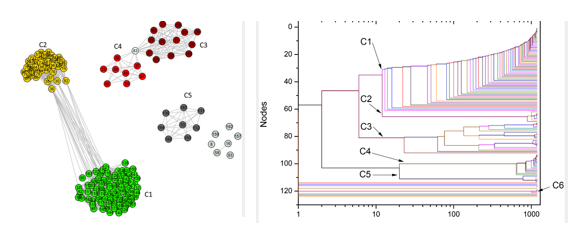
In the left, complex networks shows the proximity of different groups; in the right, the resulting phylogenetic tree
This time, the study was based on the ATP synthesis process – this molecule is considered a cellular fuel, since cells obtain energy by breaking it. Andrade and his group compared the molecular structures that lead to ATP synthesis in bacteria and in mitochondria, to find out which bacteria were most genetically close to the organelle.
“Our main result was that Rickettsiales bacteria are not closely related to mitochondria”, says Andrade. “The work indicated that Rhodobacterales, Rhizobiales and Rhodospirillales are groups closer to the organelle”.
The work was published this year in PLOS and can be found here.
Continue Reading | Comments Off on Colloquium discusses complex networks and evolution
Colóquio discute redes complexas e evolução
No colóquio da última quarta-feira, o pesquisador Roberto Andrade, da Universidade Federal da Bahia, falou sobre seus trabalhos mais recentes envolvendo redes complexas para o estudo da evolução. Andrade e seu grupo propõem um novo método para a organização de seres vivos e de sua evolução, tradicionalmente feita através de árvores filogenéticas baseadas em morfologia e características moleculares.
“Nossa proposta é classificar organismos com base em similaridades de componentes envolvidos na síntese de moléculas básicas”, diz Andrade. “Em um trabalho, estudamos fungos baseados em quitina. Depois, em um projeto mais ambicioso, tentamos estudar a origem evolucionária das mitocôndrias”.
O pesquisador explica que muitos organismos possuem seu próprio “conjunto” de enzimas para obter uma molécula que é encontrada em várias espécies diferentes. Por conta disso, é possível classificar a proximidade genética entre elas ao estudar as diferenças entre suas maquinarias celulares.
Exemplo dessa situação ocorre com a quitina – a molécula é o principal componente da parede celular de fungos. Diferentes espécies, porém, obtêm a quitina através de processos distintos. Andrade e seu grupo utilizou como base os dados do NCBI (National Center for Biotechnology Information) e comparou os mecanismos moleculares de diversas espécies.
“A classificação à qual chegamos coincidiu completamente com as de árvores filogenéticas anteriores”, diz Andrade. “A diferença é que o método que usamos é mais rápido para se obter a classificação final”.
Origens da mitocôndria
“Depois desse trabalho, ficamos mais ambiciosos”, conta Andrade. “Começamos um trabalho para tentar descobrir a origem evolutiva da mitocôndria”.
Apesar de muitas teorias tentarem explicar a evolução da mitocôndria, a questão ainda intriga cientistas. Para quem não está familiarizado com biologia, a mitocôndria é uma organela que possui seu próprio DNA. Algumas hipóteses, como a Teoria Endossimbiótica, propõem que a mitocôndria teve sua origem a partir de um organismo procarionte (que não tem núcleo celular) que viveu em simbiose com uma célula eucarionte (que tem núcleo celular).

À esquerda, redes complexas mostram a proximidade entre diferentes grupos; à direita, a árvore filogenética resultante
O estudo, dessa vez, foi baseado no processo de síntese de ATP – molécula que é uma espécie de combustível celular, pois sua quebra fornece energia para as células. Andrade e seu grupo comparou as estruturas moleculares que levam à síntese de ATP em bactérias e em mitocôndrias, para tentar descobrir qual bactéria estava mais geneticamente próxima da organela.
“Nosso principal resultado foi que bactérias da ordem Rickettsiales não tem relação próxima com mitocôndrias”, diz Andrade. “O trabalho indicou que Rhodobacterales, Rhizobiales e Rhodospirillales são grupos mais próximos da organela”.
O trabalho foi publicado esse ano na revista científica PLOS e pode ser visto aqui.
Continue Reading | Comments Off on Colóquio discute redes complexas e evolução
Studying evolution and cooperation with Game Theory and Complex Networks
In the second week of the School on Complex Networks and Neuroscience, the lectures of Jesús Gómez-Gardeñes discussed how Game Theory ideas can help in studies of biology and evolution. His research focus especially on the mechanisms related to cooperation and imitation behavior in human populations.
Game Theory
Game Theory ideas have applications in several areas, from economics to biology. The main purpose of the area is to find the best strategy, or alternative, when we face a problem in nature or society.
“With Game Theory we can “mathematize” conflicts and dilemmas, which allows us to calculate the best solution for them”, says Gardeñes.
A classic example of the area is the “Prisoner’s Dilemma”.
One way to solve problems like this one is to calculate the Nash Equilibrium for the situation – the result will show what strategy is the best one. In the Prisoner’s Dilemma case, telling on your friend is the best option.
Evolution
Game Theory can be applied in studies of biology and evolution. One of the first works in the area, “The logic of animal conflict,” was written by John Maynard Smith and George Price in 1973 and published in Nature. In the article, the researchers imagine a situation where two species, like hawks and doves, compete for the same resource.
In this simplified case, imagine that when a dove competes with another dove for food, they share the resource. When a hawk competes with a dove, the hawk gets the resource. And when two hawks compete for food, they will fight – their final result will be the resource minus the damage they take in the conflict. So, what species would be favored by evolution?
“Game Theory can show how different strategies adopted by different species have different success rates”, explains Gardeñes. “So the process of natural selection will favor animals that adopt the strategy that provides the best results”.
In the example between hawks and doves, if the damage caused by the conflict between hawks is large, the dynamic tends toward an equilibrium, suggesting that the two species can coexist. When there are many hawks, the chances of two animals of this species meeting and fighting is high, favoring doves. When there are many doves, hawks are favored as they will have a good chance of winning the resource. In Game Theory, hawks and doves can represent different types of animals or different types of behavior of individuals of the same species.
Cooperation
According to Game Theory ideas, in most situations cooperation is not a strategy that would succeed in nature. Therefore, several studies try to understand how cooperation emerged, evolved and managed to survive in a great variety of communities. Some hypotheses say that this strategy favors the preservation of genes, as there is the possibility of increasing the chances of survival of your family members if you cooperate with them. In other communities, individuals that don’t cooperate might be punished.
“In my research, I try to understand cooperation in human populations”, says Gardeñes. “Through studies of complex networks, we can better understand how people relate to each other”.
Gardeñes points out that humans are different from animals, as they can change strategy at any time. While a dove can’t choose to behave like a hawk, we can change our behavior. One of the reasons that make us change our strategy is by observation: when we see someone else adopt a different strategy from our own and be successful, we can choose to imitate him.
“My work also aims to understand the mechanisms of imitation strategies in humans,” says Gardeñes. “Our objective is to create simulations that are as close to reality as possible. One of the ways of doing this is to add multiple networks to the system: related to work, friendships, family and so on”.
Continue Reading | Comments Off on Studying evolution and cooperation with Game Theory and Complex Networks
